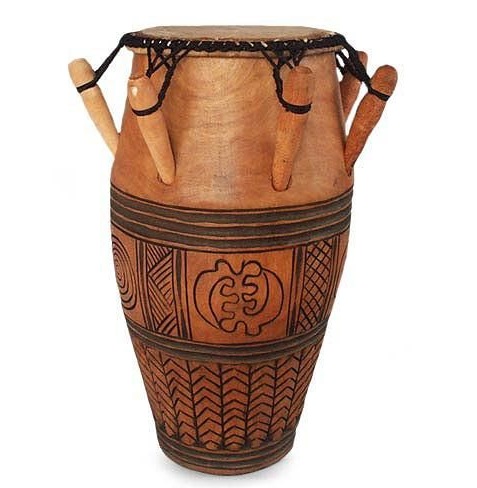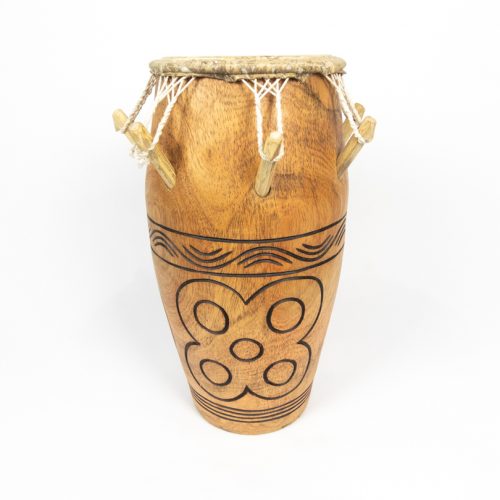Kpanlogo drum
Percussions
Africa
Between 1901 and present
Video
The Kpanlogo drum is a traditional musical instrument originating from the Ga people of Ghana, specifically from the Greater Accra Region. Known for its distinctive barrel shape and vibrant sound, the Kpanlogo has become a symbol of cultural expression and community identity. Typically made from hardwood, the drum features a head made from animal skin, such as cow or goat, which contributes to its warm and resonant tones. The Kpanlogo is not only a musical instrument but also an integral part of social gatherings, celebrations, and various cultural events within the Ga community.
Type of Instrument
The Kpanlogo is classified as a membranophone, a category of musical instruments that produce sound primarily through the vibration of a stretched membrane. This classification emphasizes its role as a percussion instrument, where the sound is generated by striking the drumhead with the hands. The Kpanlogo is similar in shape to other barrel drums found in different cultures but has unique characteristics that set it apart, including its specific construction materials and playing techniques.
History
The history of the Kpanlogo drum can be traced back to West Africa, particularly during the mid-20th century. Emerging in the 1960s, Kpanlogo music was developed as a modern urban youth genre that blended traditional rhythms with contemporary influences like highlife music. This evolution marked a significant cultural shift, reflecting the social changes occurring in Ghana during this period. The Ga people have long used various types of drums in their musical practices, but the Kpanlogo gained prominence after Ghana’s independence in 1957. As a symbol of national pride and cultural identity, the Kpanlogo became associated with celebrations and public festivities. Its rhythmic patterns and lively performances resonate deeply with the communal spirit of the Ga people.
Construction
The construction of a Kpanlogo drum involves careful craftsmanship and attention to detail. Typically carved from a single piece of hardwood such as twenaboa or mahogany, the drum’s body is hollowed out to create a resonating chamber. The drumhead is traditionally made from animal skin, often sourced from young cows or goats. This skin is carefully stretched over the top of the drum and secured with pegs or ropes to ensure proper tension.The dimensions of the Kpanlogo can vary, but it generally measures around 10 to 14 inches in diameter and about 24 inches in height. The craftsmanship often includes intricate carvings and designs that reflect cultural motifs and symbols significant to the Ga people.
Types of Kpanlogo Drums
Several types of Kpanlogo drums serve different roles within musical ensembles:
Lead Drum: This drum is tuned to produce higher pitches and plays intricate melodic patterns.
Support Drums: Typically two support drums accompany the lead drum; one is tuned lower for deeper sounds while the other provides intermediate tones.
Ceremonial Drums: These may feature more elaborate designs and are used specifically for important cultural rituals or celebrations.
Portable Drums: Smaller versions designed for ease of transport are often used by street performers or during informal gatherings.
Each type contributes uniquely to the overall sound and rhythm of Kpanlogo music.
Features
The Kpanlogo drum is a traditional African percussion instrument originating from the Ga tribe of Ghana. It is an integral part of Kpanlogo music and dance, known for its vibrant rhythms and cultural significance. The drum is typically crafted from a hollowed-out hardwood body, often carved with intricate designs that reflect African artistry and heritage. The drumhead is made from animal skin, usually, goat, stretched tightly over the open end and secured with pegs, ropes, or metal rings, allowing for tuning and tonal variation. Its compact, cylindrical shape makes it portable and versatile, suitable for various musical contexts.
It produces a rich and resonant sound, with players using their hands to create dynamic rhythms. The technique involves striking different parts of the drumhead to generate a range of tones, from deep bass to sharp slaps. It often accompanies traditional storytelling, ceremonies, and social gatherings, fostering communal connection and expression. The Kpanlogo drum’s rhythmic patterns are highly syncopated, embodying the essence of African polyrhythms. Its vibrant presence and cultural roots make it an enduring symbol of Ghanaian heritage and African music.
Sound Production
Sound production in the Kpanlogo occurs through various striking techniques. When played, drummers use their palms and fingers to hit different areas of the drumhead:
- Bass Stroke: Produced by striking the center with an open palm, creating deep resonant sounds.
- Tone Stroke: Achieved by using fingertips near the rim for a higher-pitched sound.
- Slap Stroke: A sharp sound created by quickly striking the edge with fingers.
These techniques allow drummers to create complex rhythmic patterns that are characteristic of Kpanlogo music. The interplay between different strokes adds depth and texture to performances.
Playing Methods and Roles in Music
The Kpanlogo drum is a traditional percussion instrument originating from the Ga people of Ghana. It plays a central role in Kpanlogo music and dance, a popular genre performed at festivals, social gatherings, and cultural events. The drum’s construction and techniques reflect the rich cultural heritage of West Africa.
The playing methods of the Kpanlogo drum rely on three main hand techniques: the slap, the tone, and the bass. The slap creates a sharp, high-pitched sound by striking the edge of the drum with fingers slightly spread. The tone, achieved by hitting the drumhead closer to the edge with fingers together, produces a mid-range, rounded sound. The bass, the lowest and deepest sound, comes from striking the center of the drum with the full palm. These techniques are combined in rhythmic patterns to convey energy and emotion, often mimicking spoken language or storytelling. Players typically sit or stand, holding the drum between their knees or using a strap for mobility.
In Kpanlogo ensembles, the roles of the drummers are distinct and highly collaborative. The master drummer leads the performance, guiding the other musicians and dancers with improvisation and call-and-response cues. This role requires exceptional skill and the ability to communicate effectively through rhythm. Supporting drummers maintain the foundational rhythms, creating a steady pulse that anchors the ensemble. Together, the players interweave their parts, forming a complex and dynamic tapestry of sound. The interaction between the drummers, dancers, and audience fosters a communal experience, central to the Kpanlogo tradition.
Through its playing methods and roles, the Kpanlogo drum exemplifies the power of rhythm in storytelling, community bonding, and cultural expression. It remains an enduring symbol of Ghanaian identity and artistry.
FAQ
What materials are used to make the Kpanlogo drum?
The Kpanlogo drum is crafted from hardwood, often tweneboa or similar durable woods. The drumhead is traditionally made from goat skin, stretched and secured with pegs or ropes. The body is typically hand-carved, featuring a cylindrical shape with a hollowed-out center. These materials create a resonant, warm sound that is essential to its performance.
What are the key features of a Kpanlogo drum?
The Kpanlogo drum features a compact cylindrical design, with a carved wooden body and a taut goat-skin drumhead. It is played using hands, sticks, or a combination of both. The drum often has decorative carvings or motifs representing Ghanaian culture. Its tone is versatile, producing deep bass and sharp, resonant slaps.
What are the different types of Kpanlogo drums?
Kpanlogo drums vary in size, ranging from small handheld versions to larger, floor-standing models. They can also differ in carving styles and designs, reflecting cultural influences. While most are traditional, some modern variations use synthetic materials for the drumhead. The types are tailored to suit specific performance needs and styles.
 Links
Links
References
Other Instrument
Categories



















